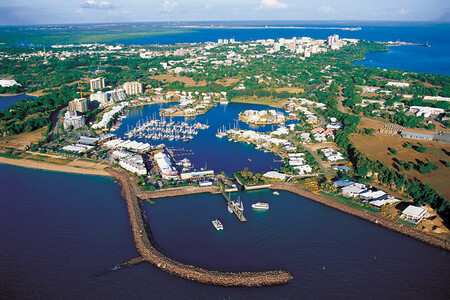Australia is a peculiar country. Not so much for their culture, a mixture of indigenous and western customs, but because it has become in the eyes of the rest of the world into practically a meme. And it is due to the curious variety of fauna with which it has, being a recurring joke that any bug that you find will be huge and can kill you. Among them, are the crocodiles, which are not so exotic, but they have a whole town.
The town is Darwin, and the 100,000 crocodiles that surround it are of a fairly aggressive species.
Irony. You may be thinking about it, and so it is: Darwin is named in honor of the naturalist Charles Darwin. It was founded in 1869 and, in its short history, it has had to be rebuilt on a couple of occasions. One, due to a Japanese bombing during World War II. The other by the action of a cyclone. It has 150,000 inhabitants and is the most populous capital in the north of the country, but much of its population does not walk on two legs.
Larrak. Darwin is located in a privileged enclave for outdoor sport, especially for those who enjoy sea sports. However, that exposure to the sea and one of the few rivers in the country has a small print: a population of overwhelming crocodiles. Currently, it is estimated that there are more than 100,000 crocodiles around the town, but until not long ago, the situation was completely different.
The Larrakia are the aboriginal inhabitants of that region and, for 65,000 years, they lived with the crocodiles. The reason? Double: spiritual and useful. They were revered, but because they were of great value to the people due to their flesh and eggs. These crocodiles are of a particularly aggressive species, salt water crocodiles or Crocodylus porosusand his fate changed in the mid -twentieth century.


Challenge. After World War II, the Larrakia painted little in a more westernized territory, and the crocodiles began to be dough hunted not due to their flesh, but to their skin. The fashion of the mid -century prevailed and imported little ending with entire animals, which reduced the population of crocodiles to between 3,000 individuals for the 60s.
That hunt was seen as a form of economic development due to the lucrative fashion business, but things changed in the 70s.


The little girl. In 1971 conservation policies were implanted, preventing the hunt for crocodiles and the population … exploded. If only 3,000, in 50 years they have multiplied until reaching 100,000 copies. Due to the numerous coast and warm temperatures, the territory of northern Australia is an ideal habitat for these crocodiles and, although they are an aggressive species, in recent years there have been less mortal incidents we could think.
And, because the area is ideal for both fishing and swimming, or to perform any other outdoor activity, Darwin has a system of traps and park rangers that are responsible for keeping crocodiles at bay. Especially in times of heat, when these reptiles are more restless.


Escudes. Kelly Ewin is one of these park rangers, whose work is to catch and remove crocodiles from the areas closest to the population. In BBC, there is a system composed of 24 traps that surround the city of Darwin and are designed to catch those who approach too much, especially in the port area. “Obviously, we are not going to capture all the crocodiles, but the more we take out the port, the less the risk of a meeting between crocodiles and people will be,” says this former policeman.
In addition, another tool is population education. In the northern territory, the government launched a program called “Be wise around crocodiles” to teach people how to behave responsible in the habitat of these animals. Natasha Hoffman directs the program and comments that, living in a country of crocodiles, they must know the answer to how to behave if they cross one.
“If you are on a ship when you are fishing you must be aware that the crocodiles are there. They hunt through ambush, they sit, observe and wait. If they have the opportunity to grab some food, that is what they are going to do,” says the educator.


There are also these poor people with a bad reputation due to ‘Jurassic Park’
License to kill. Now, although in the northern territory it is not allowed to kill the crocodiles massively due to that protection, but plans have been approved to increase the quota of crocodiles that can be killed annually from 300 to 1,200 with the aim of controlling the population. In addition, when there is a potentially dangerous encounter between a crocodile and a human, the park rangers have permission to end the threat.
The problem is that there are too many, they are aggressive if a human approaches too much and, as they expose in BBC, every time a death occurs, the debate that puts the possibility of mass killings is revived. There are politicians who take the opportunity to affirm that the population is out of control, something that not everyone agrees.
Business. Because not only local die: also tourists. In the same report, Alex Williams is the captain of a cruise focused on the viewing of crocodiles and states that there has been a boom of tourists in the last ten years. In addition, there are impracticable rivers. “If you are going to swim to the Adelaide River next to Darwin, there is a 100% chance of killing you. The only question is whether it will take five minutes or ten. I don’t think you never get to fifteen, you’ll end up shattered,” says Grahame Webb, an expert in these crocodiles. However, there are attractions like the ‘Cage of Death’ that allows you to swim with giant crocodiles.
And, apart from tourism, there is an intensive breach of crocodiles that spend their lives in individual cages with the aim of killing them and selling their skin to luxury marks. It is an enormously lucrative industry and it is estimated that only Australia produces 60% of the world’s crocodile skins, being the territory of the north responsible for two thirds of that production. These farms supply skins to brands like Hermès and Louis Vuitton.

Ethics. To those 100,000 wild crocodiles that surround Darwin, we must add other tens of thousands that are raised in captivity since they are born. Ecologist organizations denounce that these farms that supply luxury brands pile up young crocodiles in group pools, where they stress and it is easier for them to contract diseases such as salmonella and other bacterial infections that not only affect reptiles, but the workers and the rest of the habitat.
“We have done what very few people can do, which is to take a great predator and manage it in such a way that the public is willing to tolerate it,” says Webb, in an example of pragmatism in a complicated situation. Because the truth is that managing something like this is not simple because there seems to be no ideal way to deal with this situation.
The fights between environmentalists, intensive breeding and that do not understand ethics, politicians and descendants of the aboriginal population is a constant, but despite everything, the evidence is that 60 years ago we almost ended with these great reptiles that, now, populate the lands that belonged to them again.
Imanneses | Bidgee, tourism nt, fvan raysman, achim rakka
In WorldOfSoftware | There are young Spaniards earning $ 10,000 a month in the Australian coal mines. But everything that shines is not gold












